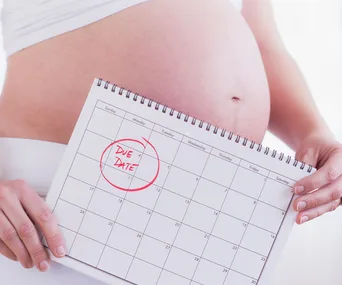Your body
Your uterus and placenta are growing to accommodate your developing baby’s needs. Six weeks ago, your uterus weighed just 140g. Now, it tips the scales at 250g.
Try this clothing hack…
If you’re not in maternity wear, you’ll probably find it tricky – if not impossible – to do up your jeans. Try this: take a hair elastic, loop it around the top button, through the buttonhole, then back around the button. Ta-da! This will help give you a smoother outline too.
Womb watch
Feel below your umbilicus (belly button) and you can easily find your uterus about 7.6cm down. Your uterus (womb) has moved up out of the pelvis, relieving pressure on your bladder. As a result, you may be able to get through the night with just one visit to the loo, instead of four!
Don’t worry if you’ve been experiencing the odd pang of pain in your abdomen – it’s caused by ligaments stretching as your uterus grows. When you feel a twinge, lie down.
Testing times
You’ve probably been wondering whether you should have any antenatal tests. Those on offer include screening tests, which tell you what your likely risk of your baby having an abnormality is. One of the most common is alpha-fetoprotein (AFP), a blood test that calculates your risk of having a baby with a neural tube defect, such as spina bifida.
There are also diagnostic tests – such as amniocentesis (see below) and chorionic villus sampling (CVS) – which reveal for certain whether or not your baby is affected by various abnormalities.
If you are over 35, have had an abnormal result from a screening test, or there’s a history of genetic abnormality in you or your partner’s family, your doctor may suggest you have a diagnostic test.
While the screening tests are completely safe, diagnostic tests carry a small risk of miscarriage. You and your partner are the only ones who can decide whether or not to go ahead. If you’re worried, discuss it with your doctor.
Do you need amniocentesis?
If you’re over 35, have a family history of genetic abnormalities or have had an abnormal result from another test, you may be offered this diagnostic antenatal test at between 16 and 18 weeks of pregnancy. It involves taking a sample of amniotic fluid from the area around the baby with a needle, using an ultrasound scan to locate the fluid. This amniotic fluid is then tested for abnormalities such as Down’s syndrome and spina bifida.

Struggling to button up your jeans? It’s no wonder as bub is now about 11cm long.
(Credit: Getty Images)Did you know?
Test results can be misleading…one of the most common reasons for unusual/abnormal results is that you’re carrying more than one baby and didn’t know!
Your baby
Your baby is about 11cm long and weighs around 80g. Her legs are longer than her arms and she can wriggle and stretch all four limbs. She’s still small enough to fit into the palm of your hand.
What’s happening
The amount of amniotic fluid around your baby is gradually increasing: she is now cushioned and protected by about 250ml of liquid. Some of your baby’s energy is being directed into developing the finer details on her body, such as fingernails and toenails. Although her eyes – which are blue behind her eyelids, irrespective of the colour they will be eventually – are still tightly closed and will remain so until 24 weeks of pregnancy, your baby now has eyelashes. Her eyes are sensitive enough to detect bright light.
That beating heart
At your next antenatal check-up, ask the midwife or doctor to listen for your baby’s heartbeat with an electronic monitor (Sonicaid), which amplifies the sound so you can hear it too. There’s no more reassuring sound than the rapid pitter-patter of that tiny heart, which beats between 120 and 160 times per minute.
Some experts believe your baby’s heart rate will reveal whether you’re having a boy or a girl. According to this theory, girls’ hearts beat faster than boys’. However, your baby’s heart rate will vary at different times of the day, so don’t rely on it to help you choose names, or nursery colours – it’s neither infallible nor scientific.

.jpg?resize=380%2C285)